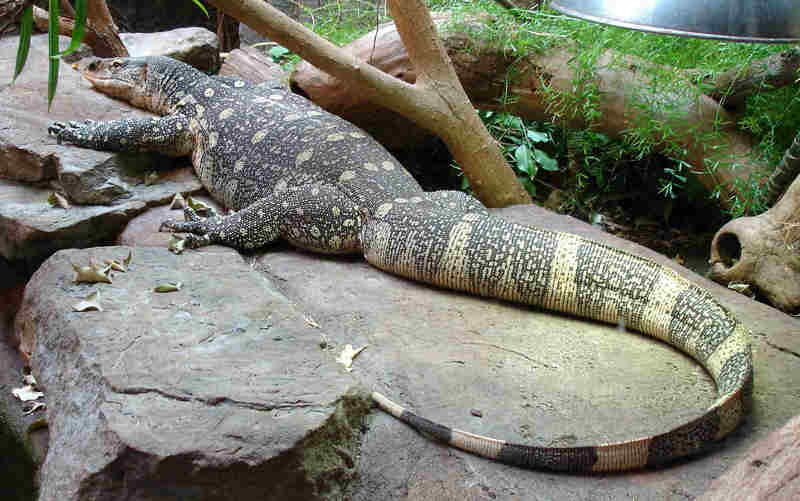| New Photos | Animal News | Animal Sounds | Animal Movies | Upload Photo | Copyright | Korean |
|---|
| Funny Animal Photos | Monsters in Animalia | Wiki Articles Fun Facts about Animals | Links | Home | Mobile A.P.A. |
|---|
| Image Info | Original File Name: Nile Monitor (Varanus niloticus).jpg Resolution: 2007x1258 File Size: 227340 Bytes Date: 2005:04:30 11:40:31 Camera: DSC-P100 (SONY) F number: f/2.8 Exposure: 10/400 sec Focal Length: 79/10 Upload Time: 2007:09:20 19:13:04 | |
| Author | Name (E-mail): Unknown | |
| Subject | Nile Monitor (Varanus niloticus) - Wiki | |
 |
| Email : E-Card | Poster | Web Master Delete Edit Info Admin |
| Description | Nile Monitor (Varanus niloticus) - Wiki
Nile monitor
The Nile monitor (Varanus niloticus) is a large member of the monitor lizard family (Varanidae). Nile monitors grow to about 6 to 7 feet in length. They have muscular bodies, strong legs and powerful jaws full of sharp teeth. They also possess sharp claws used for climbing, digging, defense, or tearing at their prey. Like all monitors they have a forked tongue, which facilitates their sense of smell. Nile monitors live in Africa and are found near their namesake, the Nile and all the way to southern Africa; they have also been introduced to Florida. Their nostrils are placed high on the snout, indicating that these animals are highly aquatic, but are also excellent climbers and quick runners on land. Nile monitors feed on fish, frogs, eggs, birds, small mammals, large insects, and carrion. In Southern Africa they are commonly referred to as "leguaan", from the Dutch for iguana. As pets Nile monitors require experienced care as pets and are not recommended for beginners, nevertheless they are often found in the pet trade. Nile monitors need a very large cage for when they are full grown their about 7ft. Due to their large size, adults are likely to require custom built quarters. Soil, sand, or bark chippings can be used as substrate. The enclosure should contain things to make a suitable habitat such as rocks, driftwood, plastic plants or hollow logs. A water dish large enough for the lizard to soak in should be used. Nile monitors have a tendency to defecate in the water dish so clean it whenever soiled or at least daily. Nile monitors should have a daytime temperature gradient of about 80-90° F (27-32° C) and a night time temperature of about 78-80° F (26-27° C). A basking spot of 140 F should be provided at least 12 hours a day. A thermometer can be used to verify the temperature. The humidity should be moderate. This species is very hardy in captivity when properly maintained. Wild caught animals should be checked for internal parasites. The Nile monitor has a very aggressive temperament with a powerful bite and a lashing tail and therefore is very dangerous. If raised with regular handling and a positive view of its keeper, a Nile monitor can to some extent be tamed.
(Bennett, D. 1995. Little Book of Monitor Lizards, Viper Press, Aberdeen, UK) In June 2007, they were sighted in and near Sanibel,Florida. In popular culture Zoo Tycoon 2: African Adventure included the Nile monitor as one of their 20 animals. http://en.wikipedia.org/wiki/Nile_monitor
| |||
| Comments |
| |||||||||||||
| Copyright Info | AnimmalPicturesArchive.com does not have the copyright for this image. This photograph or artwork is copyright by the photographer or the original artist. If you are to use this photograph, please contact the copyright owner or the poster. |
|
|
|
| |||||||
| CopyLeft © since 1995, Animal Pictures Archive. All rights may be reserved. | ||||||||
Stats